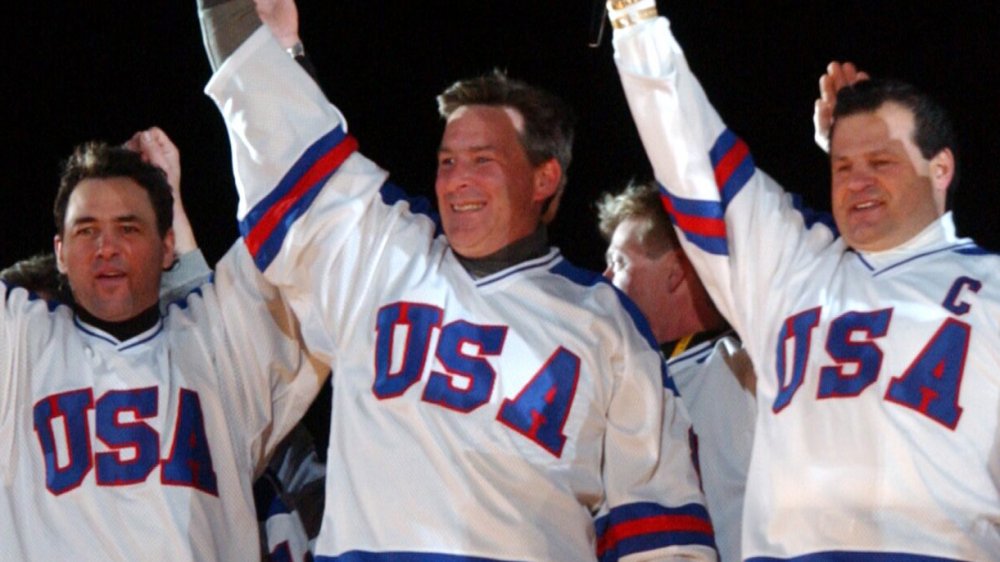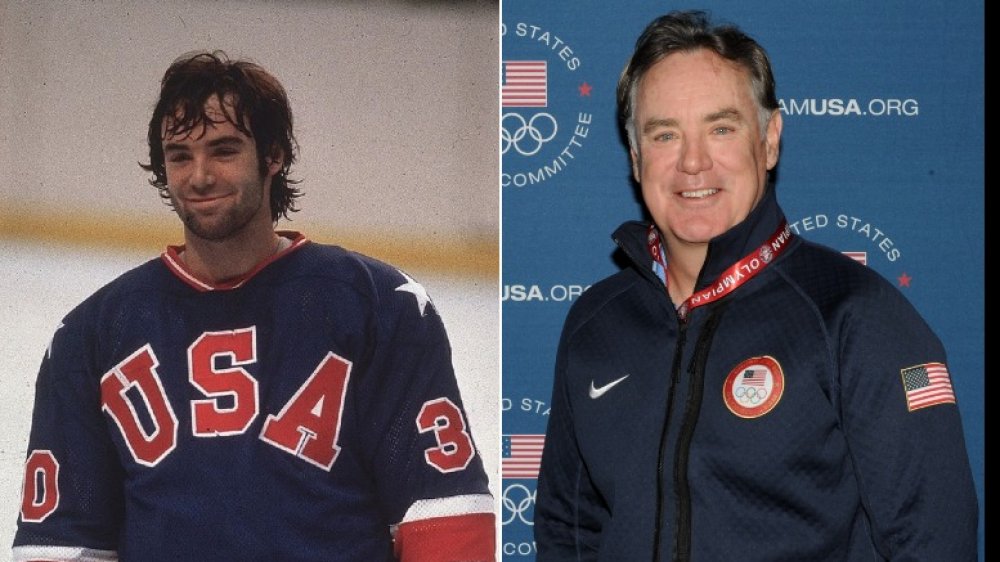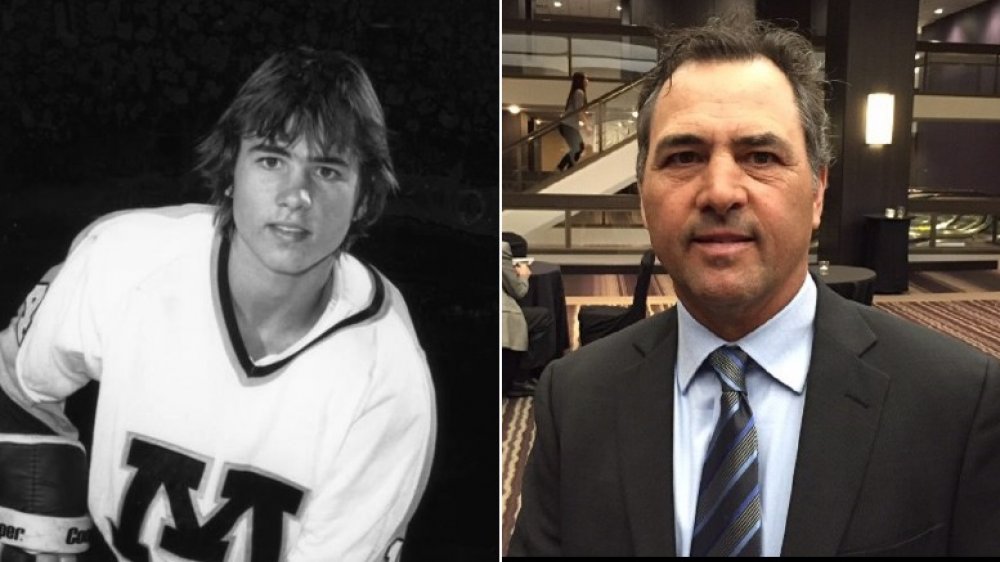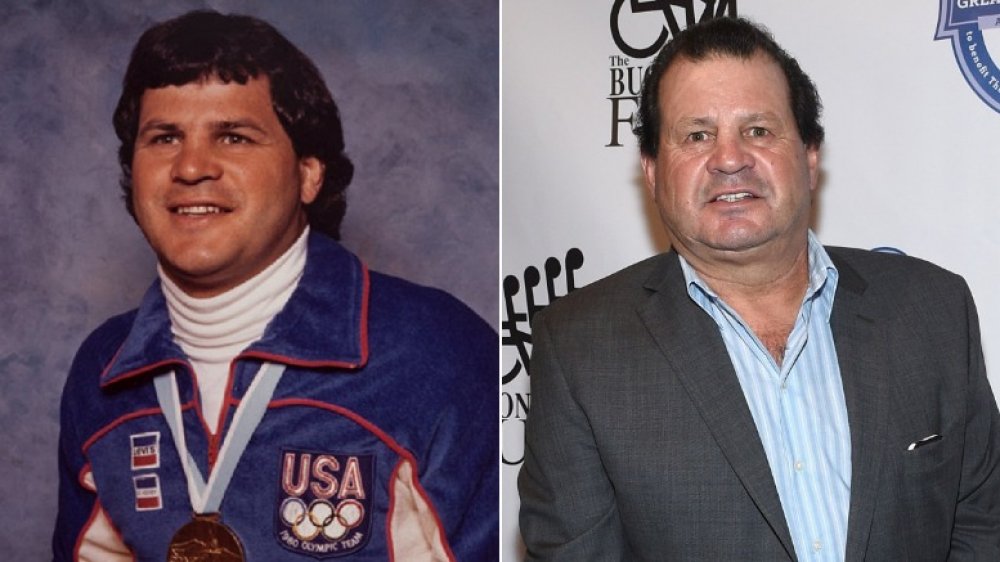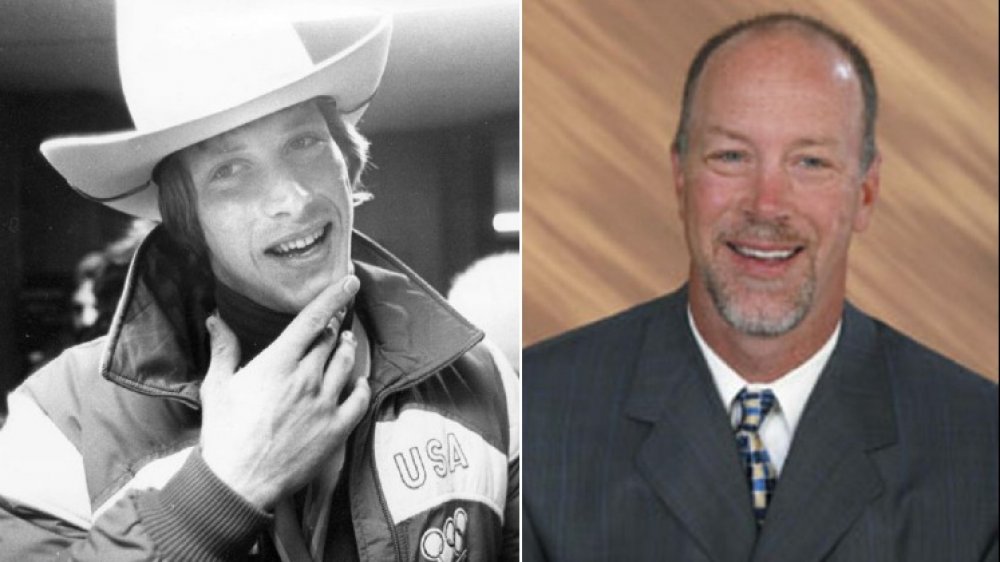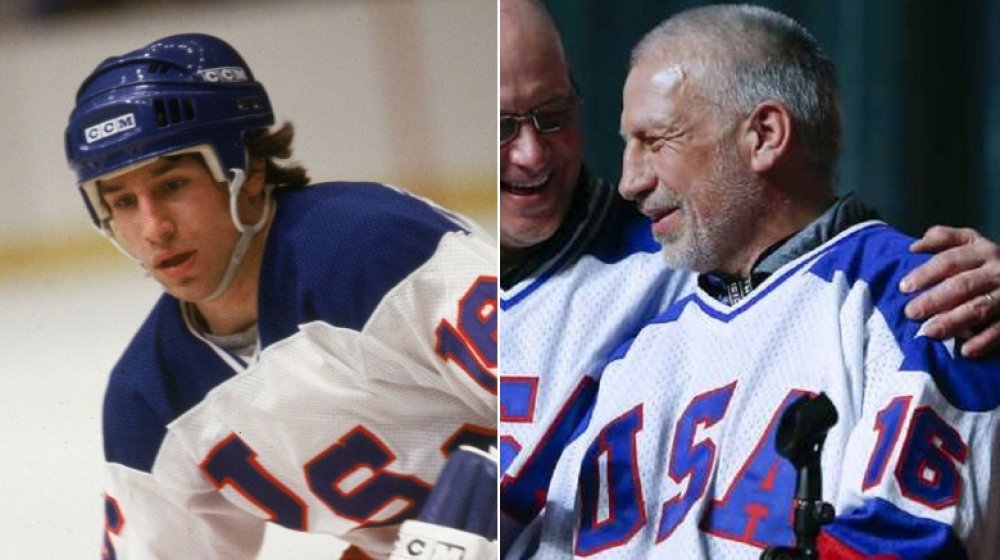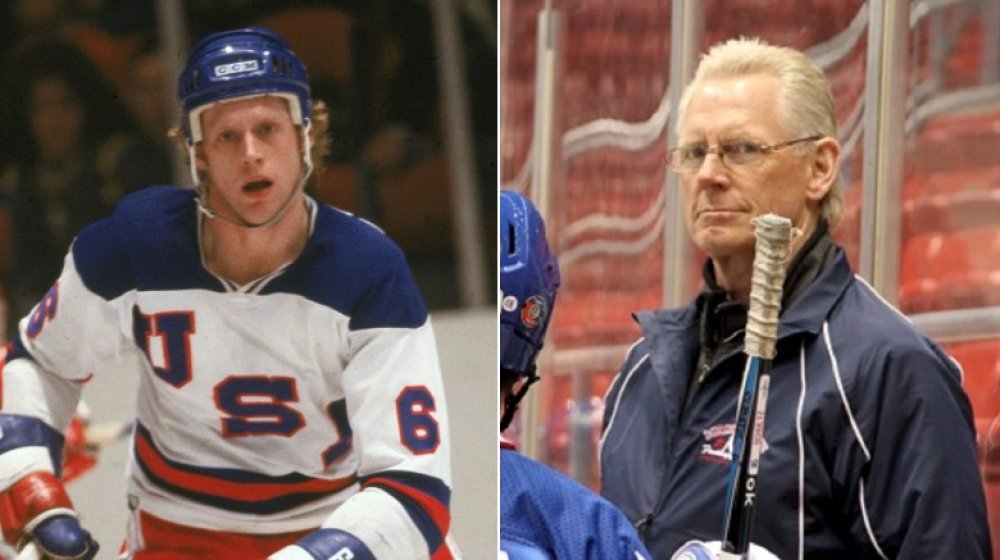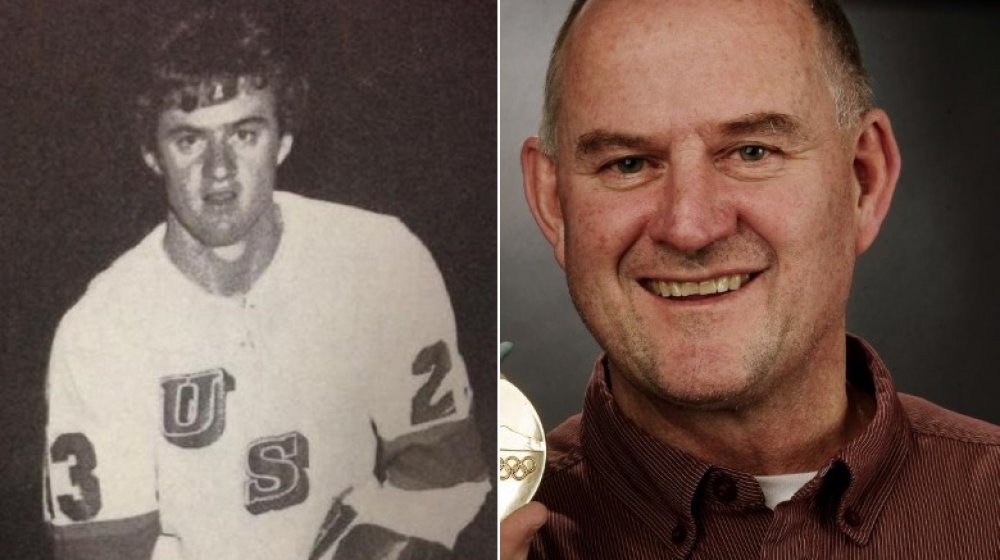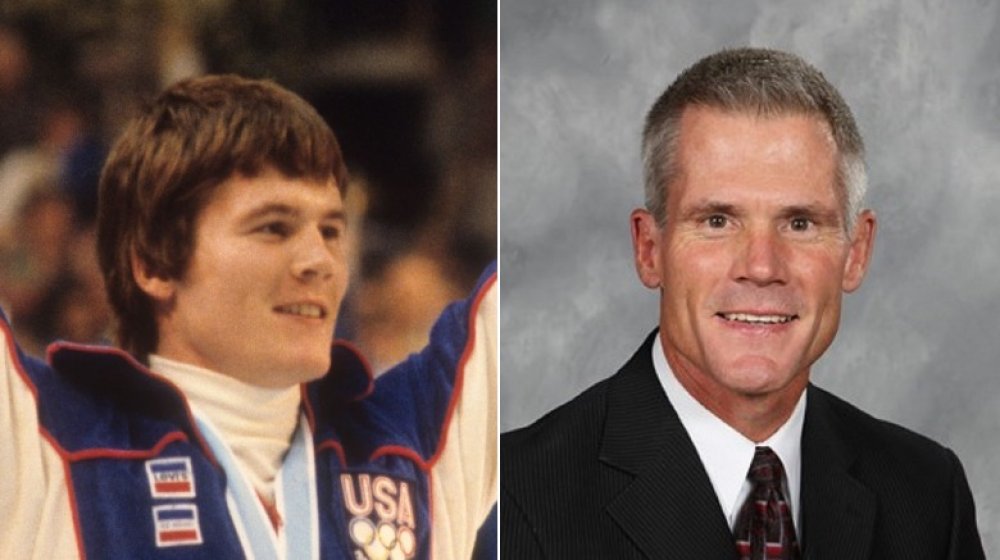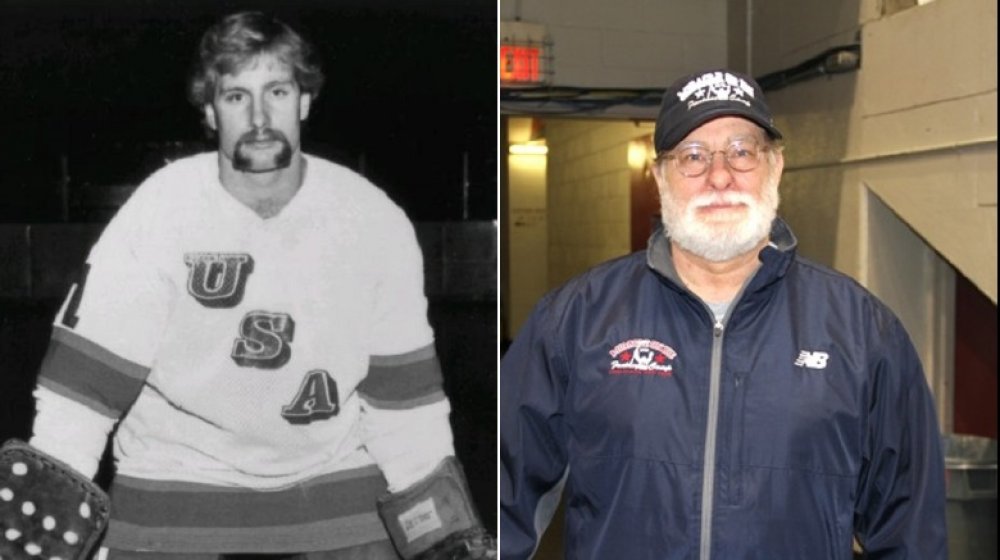What The 1980 US Olympic Hockey Team Looks Like Now
"Do you believe in miracles? YES!" When broadcaster Al Michaels uttered those words in February 1980, it was the climax of one of the greatest sports upsets of all time as the United States Olympic hockey team managed a nearly impossible victory over the powerful and highly-favored Soviet Union team. The ironic part is that because so few gave the Americans a chance (and because the country was still many years away from the ubiquity of 24-hour sports networks), the game was actually shown on tape delay. Yet nearly 40 years later, the Miracle on Ice — as it's come to be known — still resonates as one of the greatest moments in American history. It's been the subject of multiple movies and has inspired generations of hockey players that have come after them. But nearly four decades after their greatest athletic triumph, what do some of the key members of the team look like today? Read on, friends.
The 1980 US Olympic hockey team owed a lot to goaltender Jim Craig
As the starting goaltender for the national team, Craig became a household name after his performance in Lake Placid. Before that, he was a native of the Boston suburbs who stayed home and played his college hockey at Boston University. After two seasons with the Terriers, he joined up with the national team. But as a 22-year-old, he stepped into the role that would define his playing career. In the iconic game against the Russians, Craig faced a whopping 39 shots, stopping 36 of them. One of the more memorable photos from the upset win featured Craig with an American flag draped over his shoulders. That flag was eventually featured in the (now-closed) Sports Museum of America.
After Lake Placid, Craig's professional hockey career failed to truly launch. He was drafted with the 72nd pick of the 1977 NHL Entry draft but never hit the NHL ice until several years later. Craig played a total of 30 games for three different teams (Atlanta, Boston, and Minnesota) across three different seasons before he finally retired in 1984. Since then, Craig has worked primarily in sales and marketing and eventually started his own company, called (fittingly) Gold Medal Strategies. In addition to its marketing work, the company also handles Craig's work as a public speaker. However, he didn't totally leave hockey behind. From 1994-96, Craig worked as an assistant coach with the Northeastern University men's hockey team.
Forward Neal Broten went back to school after the 1980 Olympics
Broten is arguably the most decorated member of the 1980 squad, dating back to his days at Roseau High School in Minnesota. During his prep career, Broten played in three consecutive state tournaments for the powerhouse program and set a school record with four assists in a single period during a 1978 tournament game. After high school, Broten played at the University of Minnesota where he first paired with US coach Herb Brooks. As a freshman, Broten helped the Golden Gophers to a national championship, scoring the championship-winning goal against the University of North Dakota.
When the 1980 US Hockey team took the ice, Broten was a college student but the 5-foot-9, 154-pound forward held his own as part of the team's third line with Mike Eruzione and Steve Christoff, notching two goals and an assist. After the Olympics, Broten still had some college eligibility left and returned to Minnesota where he won the inaugural Hobey Baker Award, given to the country's best college hockey player. Broten was drafted by the Minnesota North Stars in 1979 and played 17 seasons in the NHL, winning a Stanley Cup with the New Jersey Devils in 1995. He was the first American player in league history to score over 100 points in a season as well as being the only player to win a Hobey Baker Award, an Olympic gold medal, and a Stanley Cup. He currently runs a horse farm in Wisconsin.
Forward Mike Eruzione gave up playing hockey after the 1980 Olympics
Mike Eruzione was one of five players from the 1980 team that was never drafted into the NHL but will forever live in hockey lore as the man who scored the winning goal in America's upset of the Soviet Union. But before that magical moment, Eruzione was a veteran of United States national team hockey. The Massachusetts native played for Team USA at the Ice Hockey World Championships in 1975 and '76. Neither tournaments were particularly memorable for the Americans. The team finished last in '75, losing all 10 games while being outscored 84-22. The squad had a much better showing the following year, finishing fourth among eight teams and winning three of its seven contests.
Despite not being drafted, Eruzione expressed an interest in playing professionally but officially retired from competitive hockey after the Lake Placid Olympic Games. Hanging up the skates didn't mean that "Rizzo" stepped away from the game. Eruzione started a career as a television broadcaster, calling games for the New York Rangers and the New Jersey Devils as well as working NHL games for both USA Network and NBC. He also kept his toes in the Olympic pool, working games for ABC and CBS. In addition, Eruzione was an assistant coach for his alma mater, Boston University, for three seasons.
Defenseman Mike Ramsey went on to play hockey professionally
Mike Ramsey was something of a hockey wunderkind in 1980. The native of Minneapolis was considered the top high school defenseman in the state of Minnesota in 1977-78 and played for Team USA in the World Junior Ice Hockey Championships in 1979 while also playing collegiately for Herb Brooks at the University of Minnesota. When Ramsey joined the Olympic team in 1980, he was the squad's youngest member. During his early career, he had been known as an offensive-minded defenseman and lived up to that reputation with a pair of assists during the Olympic tournament.
In 1979, the Buffalo Sabres made Ramsey the 11th overall selection in the NHL Entry Draft, kicking off a career that would last 18 seasons — including 14 in Buffalo. Ramsey changed up his playing style on the professional level, forgoing some of his more offensive-minded tendencies to become a stay-at-home defenseman. After nearly a decade-and-a-half with the Sabres, Ramsey spent the remainder of his career in Pittsburgh and Detroit, following coach Scotty Bowman to each stop. Ramsey ended his playing career after the 1996-97 season but returned to the NHL as an assistant coach with the Sabres. He also served as an assistant with the Minnesota Wild from 2000-10. Ramsey was inducted into the United States Hockey Hall of Fame in 2001.
Forward Mark Pavelich made history a few more times after the 1980 Olympics
Mark Pavelich was another of the 12 native Minnesotans on the 1980 US roster, hailing from the rural northeast town of Eveleth. After starring for his local high school squad, Pavelich moved on to play at the University of Minnesota-Duluth for three seasons. In his final campaign with the Bulldogs, he tallied 79 total points in 37 games. As a part of the top line for Herb Brooks' Olympic team, Pavelich was more of a facilitator than a scorer, tallying just one goal but six assists. Two of those assists came in the upset win over the Soviets, with one leading to Mike Eruzione's game-winning goal.
It wouldn't be his last stint with Team USA. He played for the national team in the 1981 Ice Hockey World Championships. Despite being one of the five US Olympians who weren't drafted by an NHL team, Pavelich was able to put together a lengthy professional career that began with a one-year stay in Switzerland playing for HC Lugano. During that season, Pavelich notched 73 points in 60 games. A year later, Brooks enlisted Pavelich to join the New York Rangers and scored 76 points in his rookie season, which remains a club record. The following season, he again made history as the first American to score five goals in a single NHL game.
Defenseman Bill Baker is in the Smithsonian
As a defenseman for the US Olympic hockey team in 1980, Bill Baker didn't exactly fill up the stat sheet. That's not uncommon for someone in his position. Yet you could argue that the one point he did score was as big as any tallied by an American in the tournament. As the extra skater late in the United States' opening game against Sweden, Baker put the puck in the net, tying the game at 2-2 and allowing the American team to earn a crucial point in Group B play. While that tie would be the only blemish on the US record in the tournament, it saved them from what would have been a potentially damaging loss in their quest to win gold. After the tournament, Baker's jersey from the "Miracle on Ice" game against the Russians was sent to the Smithsonian Museum in Washington, D.C.
Baker had a modest professional career, playing for four different teams in three seasons. After leaving the New York Rangers (where he played alongside Olympic teammates Rob McClanahan, Mark Pavelich, and Dave Silk), Baker spent a season with the Tulsa Oilers of the Central Hockey League. While the Oilers went on to win the league title, Baker was not on the post-season roster. After ending his hockey career, he returned to his native Minnesota where he became an oral surgeon before retiring in 2015.
Defenseman Dave Christian made it to the Stanley Cup Finals
While Dave Christian was part of a historic gold-medal-winning squad, he wasn't the first member of his family to have success on the Olympic ice. Christian's father, Bill, and his uncle, Roger, were members of the 1960 gold-medal team. As for the younger Christian, he joined Team USA after a collegiate career at the University of North Dakota. In his final season with the Fighting Sioux, Christian's team lost in the national championship game to a University of Minnesota team led by Christian's eventual Olympic teammate, Neal Broten.
During the Olympic tournament, Christian showed his skills as a playmaking defenseman with a team-high eight assists, including two in the gold medal game against Finland. Less than a week after claiming the gold medal, Christian started what would become a 15-year career in the National Hockey League. It was a journey that began with a bang. In his first shift with the Winnipeg Jets, Christian scored just seven seconds into his ice time, setting a record for the fastest goal by a player in his first NHL game. He would play with six teams during his career, appearing in the 1990 Stanley Cup Finals and the 1991 All-Star Game — both as a member of the Boston Bruins — before finally retiring after the 1993-94 campaign.
Forward John Harrington played hockey at the Olympics a second time
John Harrington's journey to Olympic gold was a study in perseverance. Despite being a standout high school player, Harrington wasn't offered a scholarship to play in college but was invited to walk-on for a spot on the University of Minnesota-Duluth roster. It was with the Bulldogs that he would first team up with his Olympic mate Mark Pavelich. It was after his college career that he earned an invitation from Herb Brooks to try out for the Olympic squad. He would go on to play on the team's top-scoring line alongside Pavelich and William "Buzz" Schneider. In the climactic game versus the Soviets, Harrington would be credited with an assist on Mike Eruzione's game-winning goal.
As another of the American Olympians not drafted into the NHL, Harrington earned a tryout with the Buffalo Sabres after the Lake Placid games. He was signed by the team and sent to play with the Rochester Americans of the American Hockey League. Despite a solid stint with seven points in 12 games, Harrington never made it to the NHL. He did continue his hockey career, however, by playing with the US National team on a full-time basis from 1981-83 and rejoined Team USA for the 1984 Winter Olympics. That team didn't enjoy the same level of success, finishing seventh in the tournament. After ending his playing career, Harrington had coaching stints in Europe as well as at Minnesota State University-Mankato.
Goaltender Steve Janaszak made careers in hockey and banking
Janaszak has the distinction of being the only member of the 1980 US Olympic hockey team not to log a single minute of ice time during the squad's gold-medal run. As the backup goaltender, he remained on the bench behind Jim Craig for the entirety of the tournament. However, that belies a talented player who had a remarkable amateur career. After being a star goalie at the powerhouse Hill-Murray School in Saint Paul, Janaszak went on to play at the University of Minnesota, where he helped the team win a national championship in 1979 while being named Most Valuable Player of the tournament.
After the Olympics, Janaszak signed a free agent contract with the Minnesota North Stars and appeared in one regular season game during the 1979-80 season. Unfortunately, he was on a team that already had a pair of quality goaltenders and Janaszak was sent to the minor leagues the following season. He returned to the NHL the following year with the Colorado Rockies and played in a pair of games, giving up a total of 13 goals. Janaszak retired after the 1982-83 season after spending three games as the backup goalie for Team USA during the 1982 Ice Hockey World Championships. After hockey, Janaszak moved to New York and began a career in investment banking.
Forward Mark Johnsonwent back to the Olympics as a hockey coach
It almost seemed like Mark Johnson was destined to play for Team USA. He began his international career in 1976 at age 18 when he appeared in 11 exhibition games for the national team, then coached by his father, Bob Johnson. Four years later, Johnson was ready for the spotlight in Lake Placid. As the team's starting center, Johnson led the Americans with 11 points in the tournament and tied for the team-lead with five goals. Two of those goals came during the historic 4-3 victory over the Soviet Union.
In all, Johnson would play in 13 international tournaments for the United States, though 1980 would be his only Olympic turn. Not long after starring in Lake Placid, Johnson turned his sights to a professional career. He was drafted by the Pittsburgh Penguins in the fourth round of the 1977 NHL Entry draft and begin his career in Pittsburgh during the 1979-80 season. He would play for five different teams over 11 seasons, making an appearance in the 1984 All-Star Game. Since retiring as a player, Johnson has turned his focus to coaching. He was an assistant for the men's program at the University of Wisconsin before taking over the school's women's program in 2003. Johnson added more Olympic hardware to his resume in 2010, coaching the U.S. Women's Hockey team to a silver medal in the Vancouver games.
Forward Rob McClanahan got into financial management
Rob McClanahan was one of a handful of American Olympians who played for the University of Minnesota's 1979 national championship team before winning gold in Lake Placid. However, McClanahan had a stop in between, playing in the 1979 World Championships in Moscow before joining Team USA on a full-time basis. In 63 appearances with the national team, McClanahan scored 34 goals, including five during the 1980 Olympics — the fifth and final score was the eventual game-winner in the gold medal contest against Finland.
McClanahan's lengthy amateur career didn't blossom into a particularly fruitful professional one. He was drafted by the Buffalo Sabres in 1978 and made his debut after the Olympics in 1980. McClanahan was a role player for three teams across five seasons. His best year came in 1982-83 when he played in 78 games for the New York Rangers. It was probably no coincidence that he played that season for Herb Brooks, his former coach with Team USA. McClanahan retired after the 1984 season and began a career in financial management.
Defenseman Ken Morrow no longer has a beard
Morrow was one of two Michiganders on the 1980 team, being born in Flint before leaving the state to play his college hockey at Bowling Green University. In 1979, Morrow was named the Central Collegiate Hockey Association Player of the Year. As the team's tallest player at 6-foot-4, Morrow's best game arguably was during group play when he scored a goal and registered an assist during the USA's 5-1 rout of Norway. Most notably, Morrow was the only member of the team with a beard — a trait that didn't sit well with coach Herb Brooks. However, the coach made an exception since Morrow had the beard before he joined the team.
Fresh off an Olympic championship, Morrow kept the good feelings rolling as he entered the NHL. After being selected 68th overall by the New York Islanders in 1976, he joined the club as a rookie just after the Olympics and helped the club win its first Stanley Cup title in 1980. At the time, he was the first and only player to win an Olympic gold medal and a Stanley Cup championship in one season. While he was a key member of the Islanders teams that made deep playoff runs throughout the early 1980s, Morrow continually struggled with knee injuries and was eventually forced to retire after a number of surgeries.
